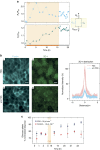Organic transistor platform with integrated microfluidics for in-line multi-parametric in vitro cell monitoring
- PMID: 31057869
- PMCID: PMC6445009
- DOI: 10.1038/micronano.2017.28
Organic transistor platform with integrated microfluidics for in-line multi-parametric in vitro cell monitoring
Abstract
Future drug discovery and toxicology testing could benefit significantly from more predictive and multi-parametric readouts from in vitro models. Despite the recent advances in the field of microfluidics, and more recently organ-on-a-chip technology, there is still a high demand for real-time monitoring systems that can be readily embedded with microfluidics. In addition, multi-parametric monitoring is essential to improve the predictive quality of the data used to inform clinical studies that follow. Here we present a microfluidic platform integrated with in-line electronic sensors based on the organic electrochemical transistor. Our goals are two-fold, first to generate a platform to host cells in a more physiologically relevant environment (using physiologically relevant fluid shear stress (FSS)) and second to show efficient integration of multiple different methods for assessing cell morphology, differentiation, and integrity. These include optical imaging, impedance monitoring, metabolite sensing, and a wound-healing assay. We illustrate the versatility of this multi-parametric monitoring in giving us increased confidence to validate the improved differentiation of cells toward a physiological profile under FSS, thus yielding more accurate data when used to assess the effect of drugs or toxins. Overall, this platform will enable high-content screening for in vitro drug discovery and toxicology testing and bridges the existing gap in the integration of in-line sensors in microfluidic devices.
Keywords: bioelectronics; in vitro; in-line sensors; microfluidics.
Conflict of interest statement
The authors declare no conflict of interest.
Figures





References
-
- Avior Y, Sagi I, Benvenisty N. Pluripotent stem cells in disease modelling and drug discovery. Nature Review Molecular Cell Biology 2016; 17: 170–182. - PubMed
-
- Breslin S, O’Driscoll L. Three-dimensional cell culture: The missing link in drug discovery. Drug Discovery Today 2013; 18: 240–249. - PubMed
-
- Elliott NT, Yuan F. A review of three-dimensional in vitro tissue models for drug discovery and transport studies. Journal of Pharmaceutical Sciences 2011; 100: 59–74. - PubMed
LinkOut - more resources
Full Text Sources
Other Literature Sources
Miscellaneous
